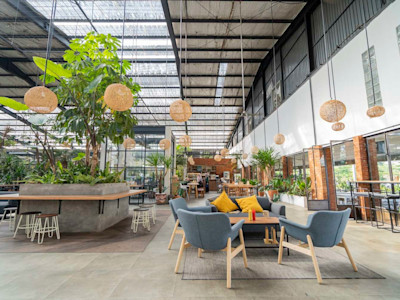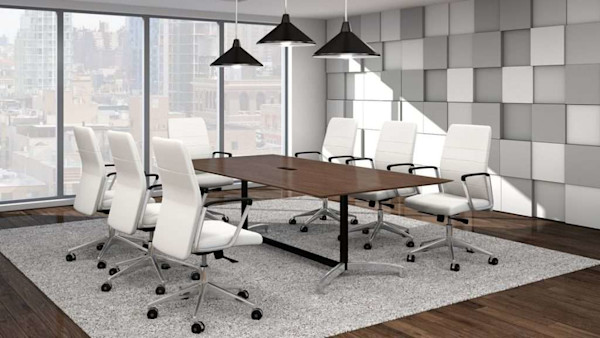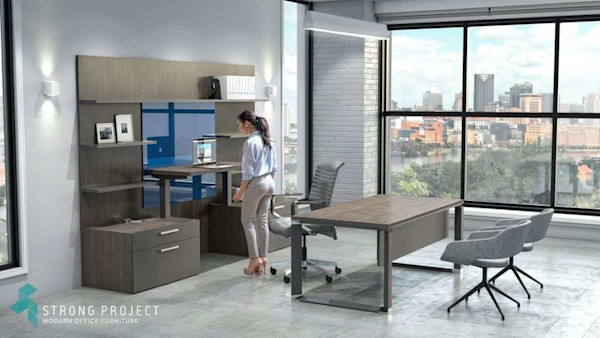Flexible Lighting In Modern Office Design

In recent articles, we’ve showcased the post-Covid workplace furniture options we offer and expect to see in modern offices worldwide. Equally important to the commercial workplace is flexible lighting. Times and conditions continue to change at a remarkable rate these days, and the office will adapt because one thing will always exist–work. Business owners who commit to flexible design during this era will invest in their organization and its human capital. Nimble floorplans, stunning modular furniture, and practical flexible lighting are some of the ways companies will upfit their modern spaces to meet the current moment and beyond.
Why Thoughtful Lighting Is Necessary
First, let’s cover why lighting is essential. Lack of natural light, imperfect bulbs, the temperature and color inferior lights emit, and their placement must be carefully considered as the lighting in the office, just as in the home, creates mood and setting. Inadequate lighting has a detrimental effect on employees by causing eye-strain, poor spirits, lackluster energy levels, and low productivity.
When incorporated into the office, flexible lighting emphasizes more agreeable and sensible choices for differing rooms and purposes.
A study conducted by the American Society of Interior Designers showed that 68 percent of employees were dissatisfied with the lighting situation in their offices. According to Leo Widrich, co-founder of Buffer, “Our cortisol levels drop significantly under artificial or poor lighting conditions. That means that we’ll be more stressed and have less ability to stabilize our energy levels.” The positive effects will be noticeable and appreciated by incorporating the right kind of light when and where you need it.

What Flexible Lighting Means In Your Office
When incorporated into the office, flexible lighting emphasizes more agreeable and sensible choices for differing rooms and purposes. Additionally, when businesses demonstrate commitments to employee satisfaction through upgrades in technology and design, people are more likely to be loyal and productive. There are fewer turnovers and healthcare costs. In other words, a little flexibility goes a long way.
Natural Lighting Is Best
Naturally, outdoor light is preferred by staff and management, and its effects are twofold. One is that it directly affects how well we see and take in information. The other, and arguably, more importantly, is the significant impact it has on our emotional and behavioral states. Offices that incorporate natural light report physically healthier employees, less tardiness and absenteeism, and increased work productivity.
Flexible lighting goes so far as to include remote, timed, and motion-detected lighting.
Of course, not all offices have windows. You can improve a windowless office atmosphere with flexible lighting options like desk lamps, fluorescent light filters, hidden lights, and cove lights. Including some of these options will reduce headaches and eye-strains employees suffer from inadequate and harsh office light.
Touchless Flexible Lighting
The way we interact with the world has permanently changed. Now, we’re accustomed to washing our hands more frequently, donning masks, and, when possible, not touching things. Flexible lighting goes so far as to include remote, timed, and motion-detected lighting. Enter a room. Let there be light! Exit the room, and lights go off, having a desirable effect on company bottom lines and germ exposure. Employees who have less direct contact with germs are not as likely to become sick and miss work.

Color and Temperature of Office Lighting
One-color does not fit all workstations or tasks. So, to have flexible lighting, you’ll need to mix up the color and temperature throughout the office depending on the specific location’s function. As a general rule, warmer yellow or orange lights promote a relaxing environment, whereas cooler blue and white lights are best for working, waking up, and concentrating. The lighting temperature and color should vary depending on the time of day. Ideally, the light should be brighter and cooler in the morning to help employees stay alert. As the day goes on, the lighting should be warmer, encouraging employees to wind down.

At Last Light
Change is shaping our adaptability and flexibility. If the workplace can improve during the pandemic and embrace these same qualities, then the return to work will be a more comfortable and welcomed transition. Companies would do well to remember that people will need a little coaxing and a few incentives to enter into a confined space with others, regardless of how much we want and need to collaborate with others. By giving them flexible lighting solutions in the workplace, you’ll show them you don’t just mean business as usual. Contact us about your post-Covid modern office design needs. Bad Mood In The Workplace? Try Changing The Lights A Healthy Office is a Happy Office Why Flexible Work Design Makes Good Business Sense



